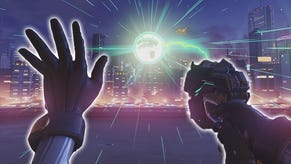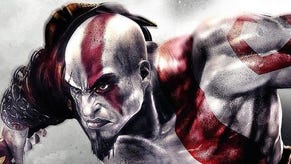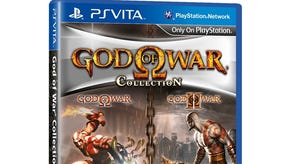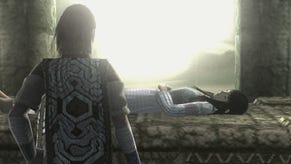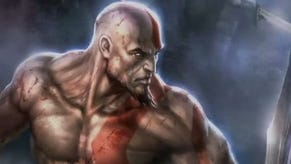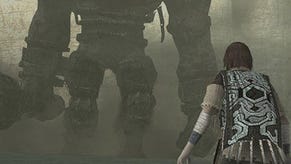God of War Collection: The Future of Backwards Compatibility?
Digital Foundry argues the Kratos.
With the recent announcement of a PAL-only God of War Ultimate Trilogy Edition pack, combined with this week's reveal of the PSP emulator for PS3, Digital Foundry decided to take a good, hard look at Sony's God of War Collection: an HD "re-mastering" of the original PS2 titles, and an interesting new solution to the age-old, thorny issue of backwards compatibility on PlayStation 3.
The God of War Collection is unique in that it not only makes two truly classic games playable on any PlayStation 3, but it also produces a range of visual and performance benefits that make it a tempting purchase even if you already own the original releases. Even if you've got a PS3 with full hardware PS2 compatibility, the Collection is so good and so keenly priced, its charms are difficult to ignore. According to November NPD data, the game sold around 180,000 copies in the USA in less than two weeks, putting it into the top 20 in one of the most fiercely competitive launch windows of the year.
While it is generally believed that Sony is working on full software emulation of the PS2 behind the scenes, Sony Santa Monica chose a different route. Both God of War and its sequel were coded in C - the same programming language that has effectively become the norm for development on the current-generation consoles. Rather than go to the effort of software-emulating an entire system, the God of War team handed the source code for the games themselves to Bluepoint Games, who then worked on effectively porting the projects across over to PS3. So, just how successful is the conversion? Can a PS2 game really look good on PS3 if it's a simple port?
Let's break out the comparison screenshots. On the top deck we see the PS2 emulation within an NTSC launch PS3 blowing up Kratos' debut to 720p resolution. Both "normal" and "smooth" modes (selected from the XMB) are captured. There appears to be very little difference here, perhaps suggesting that the mode is more to do with the deinterlacing technique used to convert the 480i PS2 output to a progressive format (God of War is a select number of games that can be run natively at 480p).
The bottom row of shots shows the God of War Collection rendering of the same scene, alongside an HD shot showing the original PS2 code running on PC via open source emulator, PCSX2. The emulator is still far from complete, and there are various glitches and issues, particularly in the handling of transparencies. However, this shot emphasises the sheer quality increase that can be attained from a simple resolution bump, with the emulation proving that the detail was there in the original assets, as opposed to being added for the God of War Collection.
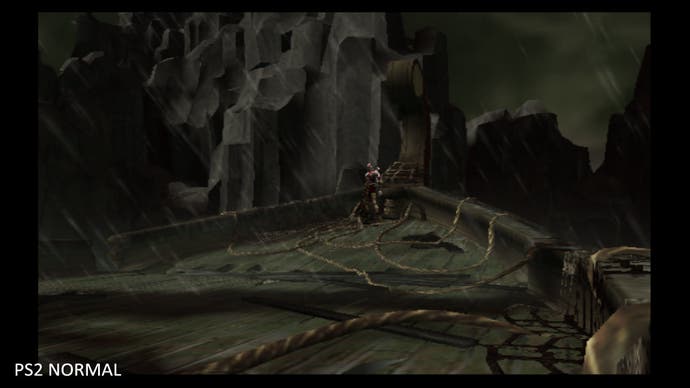

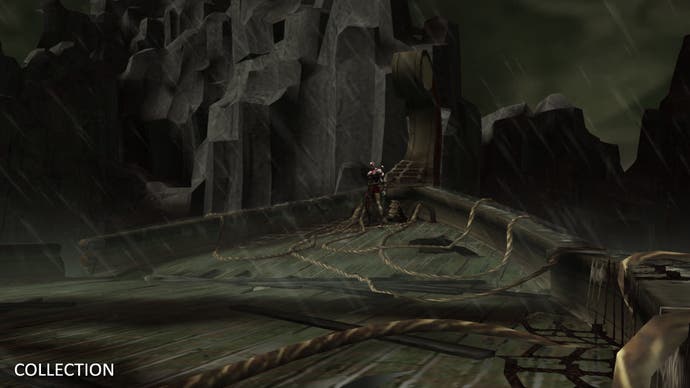

This second shot demonstrates quite beautifully that while the original art is somewhat low-poly by today's standards, the work done by Sony Santa Monica in terms of lighting plus the amount of detail given to Kratos is remarkable, and scales up in a sensational manner. That the visuals look so good and run at 60 frames per second makes for a solid, extremely attractive presentation.
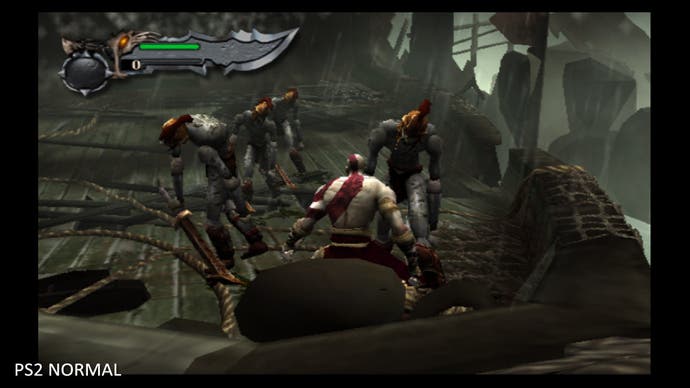
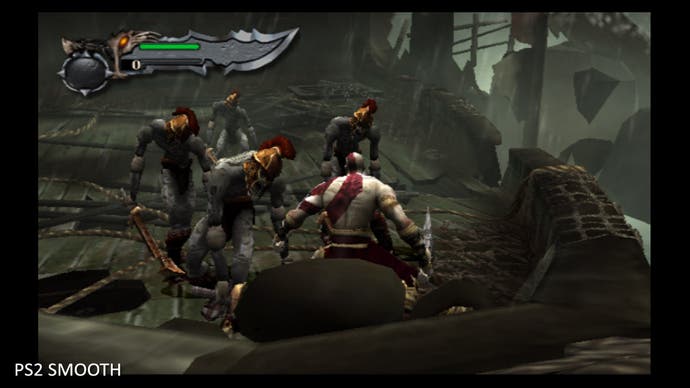
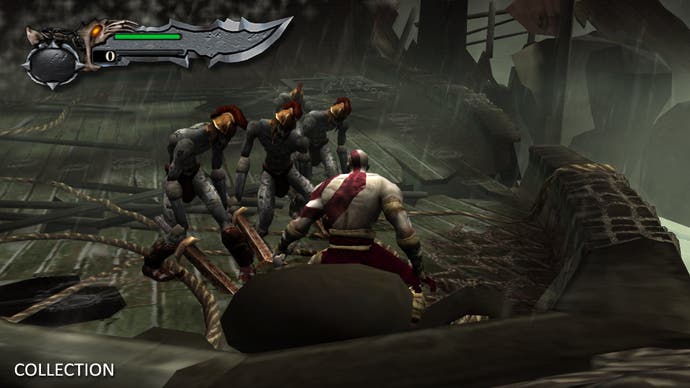
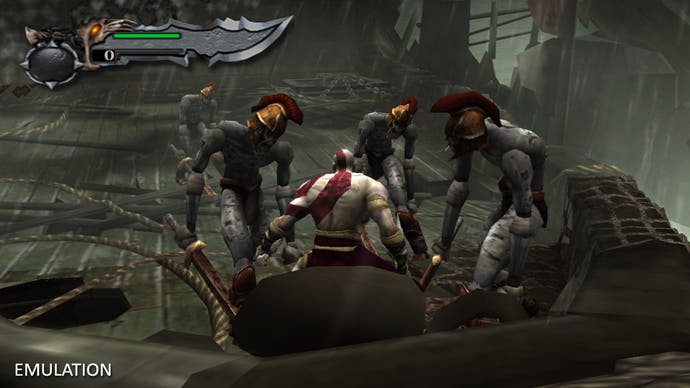
Having established that the games' artwork works so well in full-on high definition, performance is the next port of call for our tests. God of War pushed back barriers in its time for a game so rich in detail: the developers targeted 60 frames per second when they could have locked the game at 30 and given themselves a lot more overhead in rendering each frame. However, they didn't - they seemed hell-bent on producing a game as fast, smooth and responsive as possible.
There were consequences though: Sony Santa Monica opted for a 512x448 framebuffer that was anamorphically scaled outwards to give the impression of full resolution. Back in the era of the CRT display, there was no such thing as a "native" display resolution for consoles, and anamorphic scaling in this fashion worked very well indeed. Additionally, to ensure that the game offered the lowest controller latency possible and the highest possible frame-rates, v-sync was disengaged.
Performance analysis of both the original God of War running on an NTSC launch PS3 with full hardware support, compared with the God of War Collection is remarkable:
Not only does the PS3 run the game at over four times the resolution of the original game, it does so with absolutely no tearing whatsoever and adds in 2x multi-sampling anti-aliasing (MSAA) for good measure. There are performance drops, specifically with the age-old problem of transparencies, but it is very difficult indeed to feel any lag in either the frame-rate or the controls.
Playing God of War in HD on PS3 is a real treat, but it's fair to say that Sony Santa Monica's art reached a new height for the sequel, released in March 2007. God of War 2 is often perceived as the last truly great game released exclusively on PS2, but there were questions being asked internally at Sony on whether the PS3 would've been a more natural home for the game at a time when the system could really have used a profile boost in terms of its exclusives. If you've not read it, this 1UP retrospective with director Cory Barlog is well worth a read for a look back at this showcase game. According to Barlog, PS2 was settled upon as the target platform after "bouncing back and forth", as the team could refine upon what they had rather than tackling the great new technological challenges the PS3 represented.
It's perhaps ironic therefore that a conversion of the PS2 code produces a PS3 game that looks so good; a straight port carried out by a third-party developer no less. This initial comparison shot is very revealing. The quality of Sony Santa Monica's art is such that it looks as though the PS2 simply doesn't have the resolution to resolve anywhere near the full detail of the assets the team created. The fog is lifted when that same artwork is rendered in HD, be it through the porting process used for the God of War Collection, or via emulation.
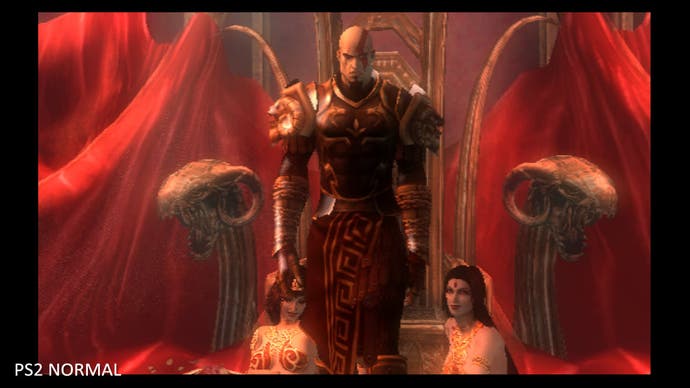

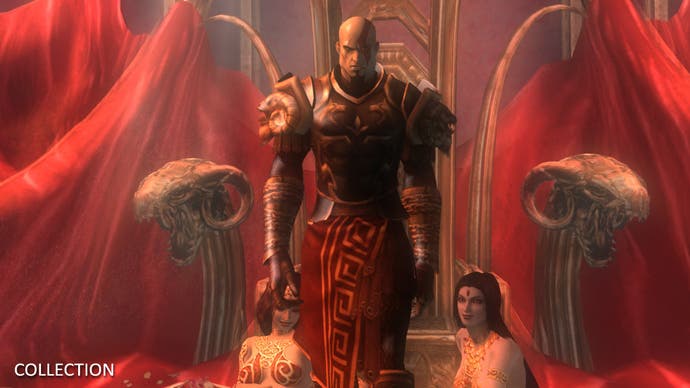

For those who've recently downloaded and enjoyed the Dante's Inferno demo, you really need to see God of War 2 running in HD on the PS3. Based on what's been revealed in the demo, it's fair to say that it's doing things that Dante isn't. Visceral Games' clone maintains 60FPS in a number of ways, but one of them is through the use of tight, confined gameplay environments. Compare and contrast with the often vast, expansive gameplay areas in God of War 2.

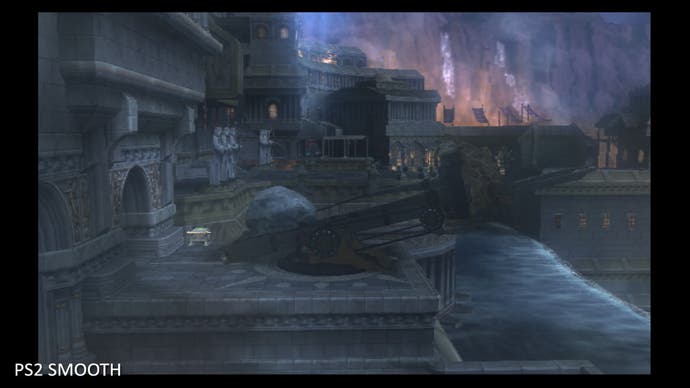


Over and above that, there is the sheer quality of the original artwork. In both of the games found in the God of War Collection, the low-poly models still look excellent simply because they were drawn with real style. While age isn't so kind on technology, it is far less impactful on basic class.


